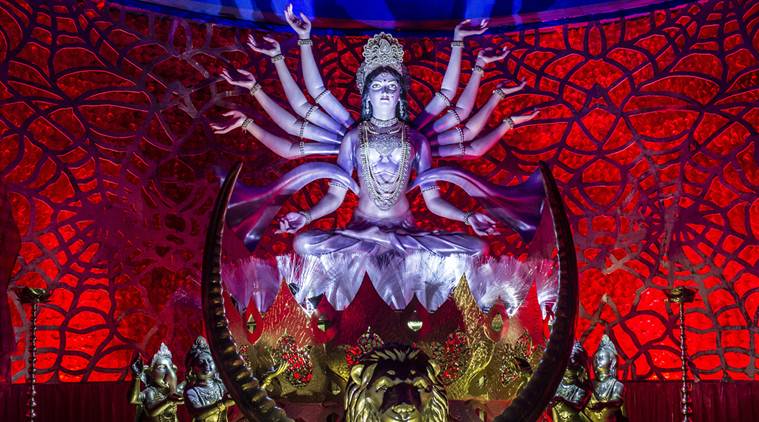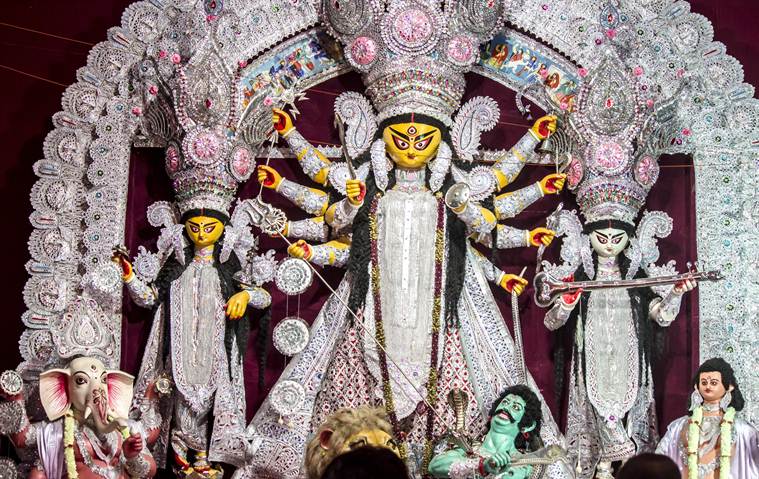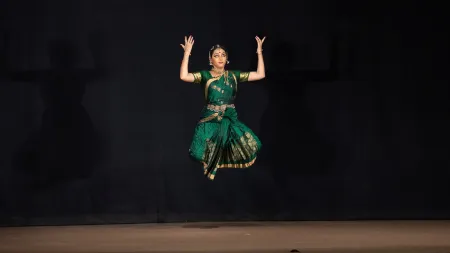- India
- International
Durga Puja 2017: Why this isn’t the real one; all you need to know about each day’s celebrations
The mega bonanza for the Bengalis is here!
 The Navratri that falls during the autumn/winter (which starts September 26 this year) is called ‘Akal-Bodhon’, meaning ‘evoked at the wrong time’. (Source: Express photo by Shreya Das)
The Navratri that falls during the autumn/winter (which starts September 26 this year) is called ‘Akal-Bodhon’, meaning ‘evoked at the wrong time’. (Source: Express photo by Shreya Das)
Durga Puja, which is widely celebrated in Bengal and other parts of the country and world, is observed with much fanfare for five days. The Hindu holy festival is mostly celebrated in the month of Ashwin, according to the lunar calendar. The festival commences on the Mahalaya, which falls on an Amavasya or no-moon night. The festival overlaps with the nine-day Navratri celebrations and ends on Dussehra, also known as Vijaydashami. The last four days during the Navratri are when the Bengali community across the globe worship Goddess Durga, along with her four children. Vijaydashami is the day after Navratri ends. Regarded as the triumph over evil, it is a festival that has a direct reference to the mythological text Ramayana.
As many know, Hindus observe two Navratris in a lunar year. The first one is usually celebrated in the month of March-April during spring. That is believed to be the original Navratri, or basically the actual time to evoke the goddess of power and piousness, according to scriptures and mythology. The one that falls during the autumn/winter (which starts September 26 this year) is called ‘Akal-Bodhon’, meaning ‘evoked at the wrong time’.
See | Durga Puja 2017: Check out the beautiful and unique Puja pandals in Kolkata
The many mythologies
According to mythology, is it said that when Sita was abducted by Ravan, her husband Ram worshipped Goddess Durga to seek blessings to defeat the ‘evil king’. It is said that Ravan – an ardent devotee of Lord Shiva and Brahma – had special boon that made it difficult for Rama to kill him, despite being split in half at one point in the battle. The stories suggest that during the war, Devi Ambika (also an incarnation of Parvati) sat in Ravan’s chariot during the battle as a symbol of support.
Disheartened by the defeat, on Bibhisan’s (Ravan’s brother who sided with Ram) recommendation, Ram decided to invoke Goddess Durga to defeat Ravan. For this, he had to offer 108 blue lotuses to the goddess to complete the puja and seek her blessings. According to various versions of the tale, Durga steals one of the lotuses just to test Ram’s devotion, leaving him with only 107 blue lotuses. It’s then that Ram – whose eyes were blue and supposedly like a lotus (he was known as Padma-lochan, literally meaning eye like a lotus) – decided to offer his own eye to the goddess as a substitute. Satisfied by the willingness to make such a great sacrifice, an appeased Durga appeared before him, thus, granting him the power to kill the demon king and also agreeing to leave Ravan’s side so that he could be killed.

Since Ram had started his worship on the sixth day of Ashwin’s Shukla-paksha after the Amabashya (Mahalaya), it is that day – known as Sashthi – which marks the beginning of Durga Puja for Bengalis.
 The traditional idols of Goddess Durga and her four children, set atop a podium. This style of idol is known as ‘Ek Chala Thakur’ meaning all idols set against one common backdrop. (Source: Express photo by Shreya Das)
The traditional idols of Goddess Durga and her four children, set atop a podium. This style of idol is known as ‘Ek Chala Thakur’ meaning all idols set against one common backdrop. (Source: Express photo by Shreya Das)
However, this is not the only history associated with it. An alternative history also suggests that the demons (asurs) had captured heaven (swarg), evicting all the gods. Disturbed and harassed by the asurs, the gods approached the supreme trinity of Lord Shiva, Lord Vishnu and Lord Brahma with the plea to defeat the demon king, Mahishasur. Apparently, Lord Brahma had granted him a boon that he could not be killed by any male god or man. Thinking that this was akin to attaining immortality, Mahishasur started wrecking havoc in all the three realms. To put an end to their miseries all gods implored Devi Parvati, Shiva’s wife, to help defeat the demon, since he could only be killed by a woman/goddess. Parvati agreed, and what followed was a long –drawn war between demon and goddess. It is said that the Devi incarnated herself into nine versions (roops) to defeat Mahishasur, who changed into various forms as well — both showcasing prominent characteristics with every formation. After the battle had gone on long enough, all the gods and goddesses assembled their strength and gifted Goddess Durga their special weapons to defeat and kill the asur king. This ‘Adi Sakti’, thus, fought a fearsome battle and killed the asur raj just as he was trying to bluff the goddess by turning into a buffalo (mahish). That is the reason we see a severed buffalo head along with all Durga idols. When the head was severed, Mahishasur was pierced with a trishul, the weapon Durga had received from Shiva.
One other school of thought also says that Mahishasur was, in fact, the greatest devotee of ‘Ma Durga’ and the entire battle was for him to attain moksh.
Along with these two mythological references about the origin of the autumn festival, in Bengal the festival is also observed as the arrival of the daughter, Uma (another name for Durga) to her maternal home from the heaven. She arrives each year with her four children — Kartik, Ganesh, Saraswati and Lakshmi — and stays for five days before again going back to her husband on Dashami. Each tale is associated with some rituals that lead to the culmination of the entire festivity.
How is Durga Puja celebrated now?
There is a precise series of events that lead to the celebrations of Durga Puja. The idol making is traditionally supposed to start on the day of the Rath Yatra (usually in July/August). The main structure of the idols — made with bamboo and stacks of hay — usually begin on this day. Over the period of next couple of months, artists would apply mud from the Ganges to mould the figurines. Traditionally the paintings of the idols would be done and kept ready and only the eyes were left to be drawn only on Mahalaya, the commencement of Devi Paksha. Mahalaya is also the day when Hindus offer homage to their forefathers and ancestors before the start of the holy festival. And by the eve of Sashthi, the idols would reach to the destination where they would be worshipped for the next five days.
According to tradition, the weapons are also not put in Durga idol’s hand before the first day of the festival. However, in keeping with modern-day pressure and demand, much has changed and a lot of the processes are expedited. The idol-making and drawing of the eyes do not happen on the specified days nowadays, but according to convenience.
On Sashthi, Day 1: September 26, 2017
The idols are set on a podium and the puja begins by placing a special matka in front of the idol. A holy thread is tied around the idols as a symbol of creating an alternative residence for them in the mortal world. Special prayers and rituals are performed and ‘life’ is instilled in to the idol, called the Pran Pratistha. As a symbol that life has been installed, the priest puts kajal on the idols’ eyes. Along with sound of drums (dhaak), conch shell (shaankh) and bells, the goddess is worshiped and one by one her weapons — all gifts from different gods — are installed in each of her 10 hands. In practice, it is also the day when mothers pray for the well-being of their children and fast the entire day. With arati and bhog, the day comes to an end.
On Saptami, Day 2: September 27, 2017
This day is special as Lord Ganesh’s ‘wife’ arrives and joins the merriment. The marital status of Ganesh varies widely in mythological stories. In Bengal, he is linked with the banana-tree bride, known as Kola Bou. The rituals start with the bathing of the banana-tree bride — known as the Kola Bou snan — in the holy Ganga water. ‘She’ is then draped in a white and red sari, and smeared with vermillion before being taken to the podium and placed with the rest of the family. However, there is much debate whether this banana-bride is Ganesh’s wife or just a version of Durga herself. The bride is made of nava-patrika (nine leaves) from trees such as the turmeric, wood apple tree, pomegranate, arum plant, rice plant, ashok tree, colacassia plant and saal tree; its hands of sugar cane; the breast is represented with two wood apples; and the arum plant root (Maan kochu) makes the base.
On Ashtami, Day 3: September 28, 2017
This day is the highlight of the festival, the main day when goddess Durga appeared before Ram. Special prayers and floral tribute is offered to the goddess known as Anjali. Flowers and leaves of the wood apple tree are offered to the gods. There is also a special bhog (meal) offered today, as opposed to the usual fare of khichdi and accompaniments on the other days. Elaborate rituals are observed during the day, including a bath with more than nine kinds of soil and water from five natural sources (from a pond to an ocean).
The transition of Ashtami and Navami is known as Sondhi, and a special prayer is offered to the deity. It is during this phase, 108 lotuses — remember Ram’s story? — are offered and 108 lamps are lit. The ceremony in the cusp of 45-50 minutes before Navami begins. This period of Sondhi is considered the most pious and powerful period of the festival.
On Navami, Day 4: September 29, 2017
To mark the culmination of the puja, a yagya is performed to appease the gods and in some places animals are sacrificed. However, over the years much has changed and a symbolic gourd or banana is sacrificed in its stead. Some places like the royal family of Sovabazar (the family of Raja Naba Krishna Deb) sacrifice fish. For non-Bengalis, many keeping the Navratri fast also break it on this day, and are free to join the gastronomic festivities this one last day.
On Dashami, Day 5: September 30, 2017
It is the last of the gala event, when the gods apparently gear up to depart from earth. The day’s rituals involve a minimalist meal for the gods, and usually the prayers are performed for a very brief period. The holy thread that was tied around the idol is broken, releasing them from mortal shackles. In the form of visarjan (going away), a mirror on which the face of the idol can be is immersed in a pot, marking a ritualistic departure. Before the idols are finally immersed in the Ganga, people see the feet of the goddess through this mirror and seek blessings. Married women smear vermillion on the deity’s forehead seeking blessing from her and bid her farewell by offering sweets.
Finally, after the customary rites, a huge procession of song, dance and music lead to the ghats, where the idol is immersed in water with the belief that the goddess and her family will go back to heaven through the water channel.
For most Bengalis, starting on Dashami, the wait for the next Durga puja begins. After all, when people say that for them the year is divided between Pujo and Waiting for Pujo, it’s pretty accurate. No true-blue Bengali will disagree!
Apr 18: Latest News
- 01
- 02
- 03
- 04
- 05




































